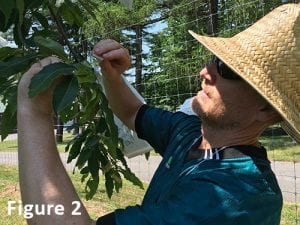Biotechnology
In 1990, the New York Chapter of The American Chestnut Foundation (NY-TACF) and the State University of New York’s College of Environmental Science & Forestry (ESF) collaborated to take a complementary approach to traditional breeding: transgenically add new genes to the American chestnut to enhance the tree’s ability to withstand blight. The most effective gene tested to date is a gene from wheat called oxalate oxidase, or OxO. The OxO enzyme breaks down oxalic acid, which is one of the primary “weapons” the blight fungus uses to attack chestnut trees. The result of this research was the development of a transgenic American chestnut dubbed Darling 58. Watch this brief animated video about the OxO gene and how it works.
Rigorous safety tests showed that there are no significant ecological effects and no negative human health consequences from inserting OxO, as this gene is naturally present in many food crops and is non-allergenic. In the 2020 winter issue of TACF’s Chestnut magazine, part 1 of a 3-part series describes tests conducted on the nuts as a food product. Part 2, in the 2020 spring issue, evaluates the safety to wildlife. Part 3, on safety to plants and fungi, can be found here.
By 2023, long term testing of the Darling line showed performance issues including variable resistance, decreased growth, more frequent leaf injury, and increased mortality, likely due to high expression of the OxO gene through the use of the 35s constitutive promoter, a genetic “switch” that keeps the gene turned on in all tissues at all times. A variety of other promoters are now being explored that may be able to switch the OxO gene on only when required.

Figure 1: Blight cankers on first generation progeny of transgenic American chestnut x wild American chestnut. The tree on the left inherited the oxalate oxidase gene and the tree on the right did not inherit the gene. The swollen canker on the transgenic tree indicates an active response to the blight and new growth around the canker, similar to cankers on some Chinese chestnuts. In contrast, the canker looks sunken on the non-transgenic tree where it has completely killed the surrounding tissue.
The resulting progeny will be essentially 100% American chestnut because none of the American chestnut genome has been removed or replaced. This characteristic allows the possibility of rescuing much of the remnant genetic diversity and local adaptations in the surviving population of American chestnut.
TACF’s chapters and staff are currently conserving 1,000 wild-type American chestnuts in orchards to use as parent trees in this diversification effort. To participate in the wild tree conservation effort contact TACF’s regional coordinator from your region. You can also donate to TACF to support restoration using transgenic blight-tolerant trees.

Figure 2: Pollination of wild type American chestnut with transgenic pollen containing the oxalate oxidase gene.
Additional Resources
- For information about TACF’s decision to discontinue developing the Darling line of transgenic trees, visit the Darling 58 page and the Darling 58 Performance page.
- TACF Strategic Science Plan 2023-2033